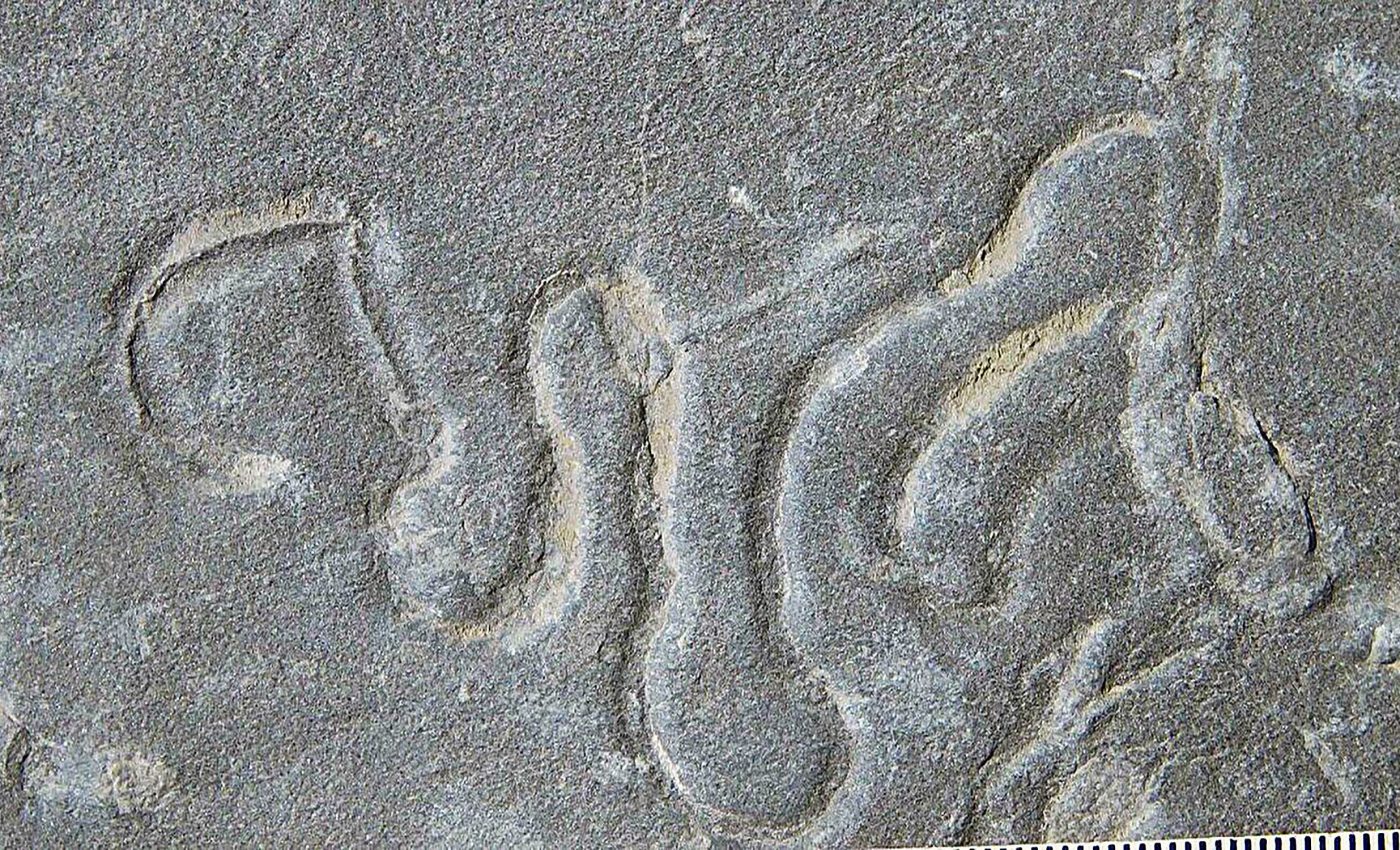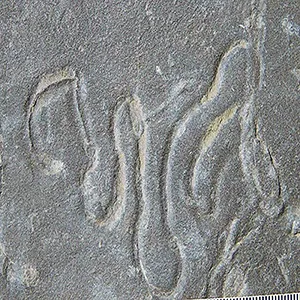
Fossil discovery casts fresh doubt on the 'burst of evolution' known as the Cambrian Explosion
These complex, looping tracks pressed into ancient seafloor mud look much more like doodles made by a child with a stick than fossils of animal movement.
However, new measurements have shown those squiggles were, in fact, purposeful movements along paths made by primitive animals navigating their world almost 550 million years ago, well before textbooks say complex life “took off” during the Cambrian Explosion.
Analysis of 170 trace fossils, which are the preserved marks of animal movement rather than the animals actual bodies, tell a much different story.
They suggest that streamlined, sensor‑rich creatures were gliding across the seabed roughly 10 million years before the start of the Cambrian Explosion, a 20‑million‑year interval beginning near 538.8 million years ago when most major animal groups appear in rocks.
Paleontologist Dr. Zekun Wang of the Natural History Museum, London, led the work with colleagues in Canada and China.
When animals started moving
The Cambrian Explosion has often been framed as a sudden evolutionary big bang that conjured eyes, limbs, and hard shells out of nowhere.
Yet the new study argues that many key traits, including directed movement and elongated bodies, emerged quietly during the preceding Ediacaran Period, which stretched from 635 million to 539 million years ago.
Wang’s team grouped the oldest tracks into three phases that mirror escalating anatomical sophistication. Early trails twist abruptly, matching stubby builders with limited perception.
Mid‑stage paths smooth out, implying better coordination. Latest tracks resemble modern worm burrows, pointing to long, hydrodynamic bodies.
“Life in the Ediacaran was no longer microscopic, but typically, it wasn’t able to move along the seafloor,” said Wang. His catalog shows that by about 545 million years ago, motion had transformed from stumble to cruise.
That timeline overlaps a sedimentary upheaval known as the Cambrian Substrate Revolution, when burrowers began churning seafloor mud and opening new ecological real estate. The traces imply the engineers of that revolution were already in rehearsal.
How ancient animals moved
Most Ediacaran body fossils are little more than quilted impressions, making it tricky to match shape to behavior. Ichnology, the study of trace fossils, fills the gap by reading sediment as a behavioral diary.
Classic ichnology relies on eyeballing trail patterns, but Wang’s group added mathematics. They calculated curvature along each path, converting wavy lines into numbers that capture turning radius and smoothness.
Paths that rarely bend sharply signal creatures with elongated, flexible trunks; jerky turns point to compact forms that pivot on the spot.

Those metrics can also hint at senses. An animal plotting a straight, efficient route was likely following chemical or tactile gradients toward food, whereas a meandering track betrays a blind wanderer bumping into meals by chance.
By comparing fossil tracks to modern analogs, horseshoe crabs, snails, and worms, the researchers estimated how animals moved and found body length‑to‑width ratios climbing from roughly 1:1 to as high as 12:1 during the final Ediacaran chapter.
Movement style and animal shapes
In a second paper, the team applied power‑spectral analysis, a signal‑processing tool more common in engineering than paleontology.
The technique isolates periodicities in trajectory curvature, teasing out repeated movement motifs such as rhythmic undulation or peristalsis.
Results hint that early trace makers moved by extending blobs of tissue, akin to giant amoebae. Later forms show signatures of muscular waves consistent with bilateral nerve‑muscle systems, the hallmark of bilaterian animals that dominate today’s fauna.
“By studying their mathematical properties instead, we can infer what the animals that made the traces might have been like,” added Wang. The numbers back a gradual rise in body coordination rather than an overnight makeover.
Because trace density also spikes near the Ediacaran‑Cambrian boundary, some researchers speculate that mobile bilaterians outcompeted stationary soft‑bodied cousins, contributing to an extinction that wiped out many iconic quilt‑patterned taxa.
Body changes over time
Curvature metrics separated paths into “unsmooth,” “regional‑smooth,” and “smooth” categories. Unsmooth tracks, older than 550 million years, loop and kink like cracked phone cords.
Regional‑smooth trails appear a few million years later, tracking short animals that likely glided with cilia or stubby legs.
Smooth trails dominate at 545 million years, matching long, tapered worms using muscular ripples to push through sediment.
Importantly, the switch did not require shells or skeletons. Streamlining alone would have lowered drag and extended sensory coverage, advantages in search of patchy microbial mats that coated the sea floor.
As body plans slimmed, animals began to burrow vertically, ventilating deeper layers and altering chemical gradients.
That engineering likely changed oxygen levels and nutrient cycling, paving the way for the bustling Cambrian seascapes familiar from Burgess Shale snapshots.
The data reinforce a view that evolution’s tempo can accelerate smoothly rather than spiking. What looks like an explosion in body fossils may instead record the moment when durable hard parts first preserved an already diverse cast of animals and their moves.
Why early animal movement matters
Mobility reshapes ecosystems by mixing sediments, redistributing microbes, and linking food webs. The Ediacaran traces show these processes igniting earlier than once thought, giving Earth an extra 10 million years of ecological tinkering before skeletons burst onto the scene.
Understanding that prelude helps resolve puzzles such as why some soft‑bodied lineages vanished while others thrived.
Animals able to seek favorable niches or escape stress would outlast immobile epifauna during environmental swings of the late Precambrian.
The work also highlights how quantitative tools borrowed from physics and computer science can wring fresh insight from humble scrapes in stone.
What once looked like random squiggles now provide centimeter‑scale snapshots of nervous systems coming online.
Next steps include three‑dimensional imaging of burrow architecture and geochemical probes that trace oxygen footprints around the tunnels, offering further clues to how early animals moved, breathed, and fed.
Looking beyond the fossil bones
The updated timeline invites revisions to evolutionary trees calibrated on the Cambrian Explosion, because behavioral innovations precede skeletal ones.
It may also adjust models of Earth’s biogeochemistry, as active burrowing accelerates the burial of carbon and sulfur.
Paleobiologists are already scanning older rock layers for similar curved tracks, hoping to push complex mobility even deeper into geological time.
Each new find tightens the connection between behavior, environment, and evolutionary opportunity.
By quantifying wiggles in mud, Wang and colleagues show that the story of animals and their moves is written not only in bones but in the graceful arcs of forgotten journeys. The quiet crawl before the boom matters as much as the boom itself.
The study is published in Proceedings of the Royal Society B.
—–
Like what you read? Subscribe to our newsletter for engaging articles, exclusive content, and the latest updates.
Check us out on EarthSnap, a free app brought to you by Eric Ralls and Earth.com.
—–













